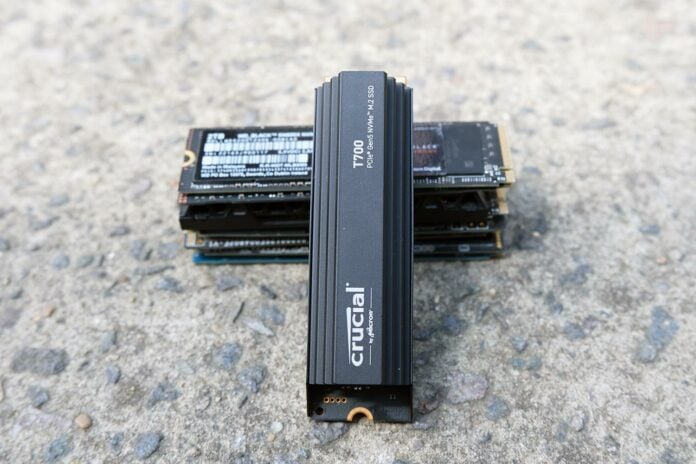Solid-state drives (SSDs) have provided a step-change in real-world PC performance. The clickety-clack of slow, spinning hard drives has thankfully been replaced by the buttery-smooth responsiveness availed by SSDs, and no modern system should be without one. Drives are now legion, with astounding value to boot, but for those enthusiasts for whom second best is simply not an option, a new breed of storage is infiltrating the premium market. Enter PCIe 5.0 models touting blazing-fast speeds. Today, we look at a veritable performance beast from Crucial, the T700.


Crucial T700 2TB
$370
Pros
- Stupidly fast
- Attractive design
- No active cooling
- 4TB option
Cons
- Expensive
Club386 may earn an affiliate commission when you purchase products through links on our site.
How we test and review products.
Sounding more like a Terminator model than a new-fangled SSD – perhaps designated this way to encourage comparisons of crushing the competition with relentless focus – T700 is now readily available in 1TB, 2TB and 4TB capacities. Fancy sequential read and write speeds well in excess of 10GB/s? Of course you do, and you’ve come to the right place as we review the 2TB model.
But before we grace the page with performance bars reaching to the far right, let’s examine the vital specs, to determine how Crucial has built this storage monster.
Specifications And Analysis
| Crucial T700 | 1TB | 2TB | 4TB |
|---|---|---|---|
| Controller | Phison E26 | Phison E26 | Phison E26 |
| NAND | 232L Micron TLC | 232L Micron TLC | 232L Micron TLC |
| DRAM | LPDDR4 | LPDDR4 | LPDDR4 |
| Interface | PCIe 5.0 x4 | PCIe 5.0 x4 | PCIe 5.0 x4 |
| Sequential Read Speed (MBps) | 11,700 | 12,400 | 12,400 |
| Sequential Write Speed (MBps) | 9,500 | 11,800 | 11,800 |
| Random Read IOPS (K) | 1,350 | 1,500 | 1,500 |
| Random Write IOPS (K) | 1,400 | 1,500 | 1,500 |
| Form Factor | M.2 | M.2 | M.2 |
| Endurance (TBW) | 600 | 1,200 | 2,400 |
| Hardware encryption | Yes | Yes | Yes |
| MSRP without heatsink | $180 | $340 | $600 |
| MSRP with heatsink | $210 | $370 | $630 |
It goes without saying, but we’re going to say it anyway; you need a compatible motherboard that features PCIe 5.0 x4 storage slots. Otherwise, fuggedaboutit, as you’ll be hamstringing the drive unnecessarily and missing the point. Most readers building a new system are safe in this regard – Intel’s 600- and 700-series boards generally offer at least one by nicking the requisite lanes reserved for the GPU, while AMD’s support is better on nascent AM5-based boards, though it really pays to do your research beforehand.
Crucial knows there are only so many ways to build a PCIe 5.0 M.2 SSD, where the interface affords approximately 16GT/s of juicy bandwidth based on a standard x4 connection. Cosying up to friends at controller manufacturer Phison and NAND from parent company Micron, T700 is born to speed.
In particular, Phison’s long history of building SSD controllers culminates in the PS5026-E26. Fabricated on a 12nm process from, who else, TSMC, the dual-CPU architecture leverages Arm’s energy-efficient Cortex-R5 technology. The eight-channel controller supports NAND speeds at up to 2,400MT/s and buffering DRAM at up to 3,200Mbps. E26’s absolute potential extends to maximum read and write speeds of 14Gbps and 11.8Gbps, respectively, according to Phison. Available with security options spanning AES 256, SHA 512, RSA 4096 and TCG Opal, it is up to the retail brand to choose and implement accordingly.
Crucial isn’t the sole recipient of Phison’s PCIe 5.0 know-how, of course, as Apacer, Corsair, Galax, Gigabyte, MSI, PNY, Sabrent and Seagate all utilise the technology. Nice to be in a commanding position, eh?
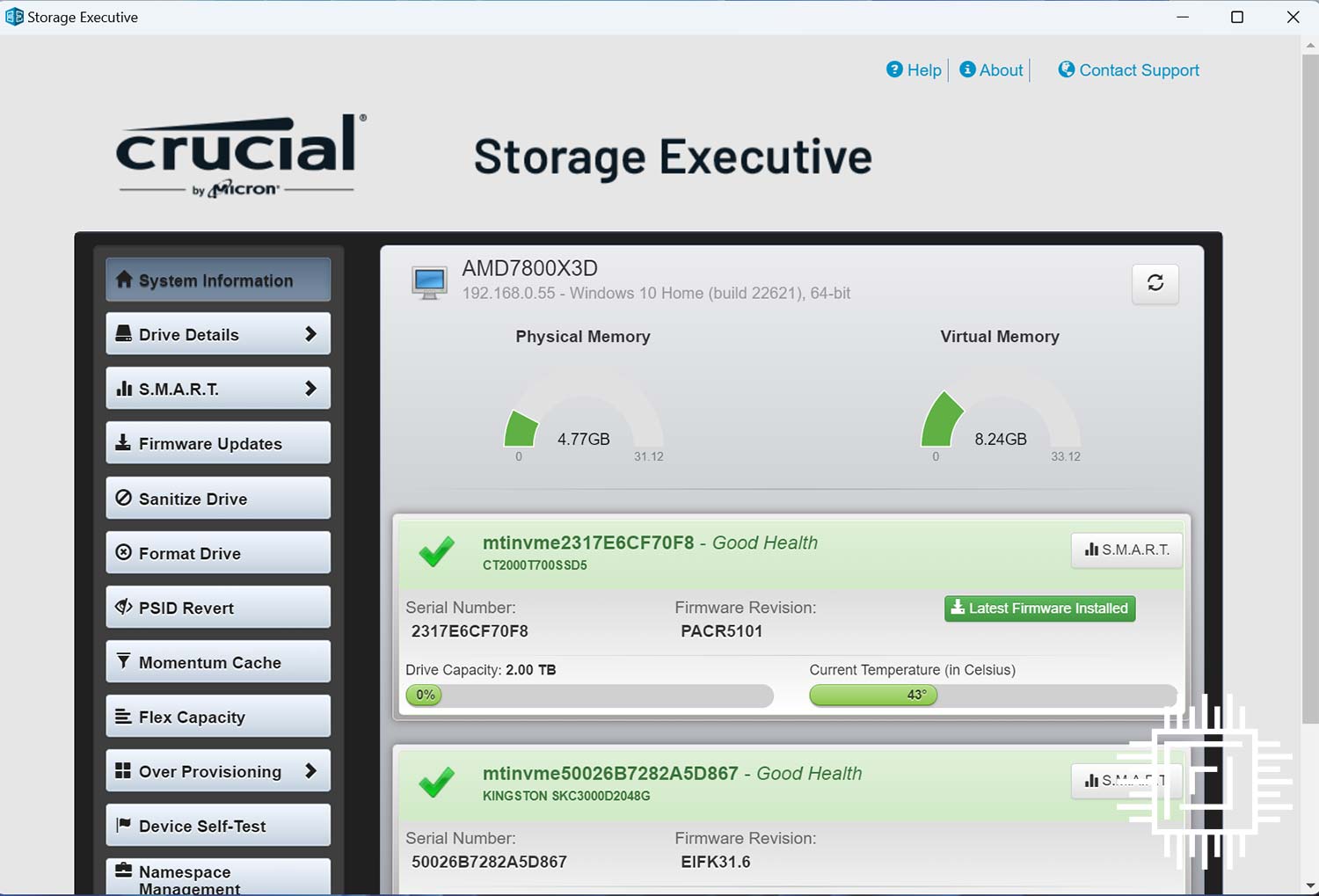
Mating this super-fast controller to Micron TLC NAND is a no brainer. Winching up the speed by using 232-layer memory operating at 2,000MT/s, it’s not quite as fast as the controller will accommodate, but we understand Crucial’s reluctance to push the boat out on first-generation drives.
Available in the three capacities with and without a dedicated heatsink – PCIe 5.0 x4 SSDs have a natural propensity to run hot – many motherboard manufacturers have started equipping premium boards with crazy-big M.2 heatsinks. Makes sense, as thermal throttling is very much on the table with badly ventilated chassis. Crucial says throttling starts when the drive hits 81°C and shutdown occurs at 90°C.
Let’s now address the rather large and obvious elephant aimlessly meandering around the room: price. In stark contrast to the excellent value now available on even premium PCIe 4.0 x4 SSDs, moving up to the Premier League of PC storage incurs a serious financial outlay. Take our 2TB heatsink-clad model as an obvious example. It costs $370 / £360. Yikes. Compare that to £117 for an admittedly non-heatsink 2TB Crucial P5 Plus PCIe 4.0 x4 offering and you quickly grasp the picture.
Hefty premiums for new technology are nothing new. Carrying on our footballing analogy, there’s a reason why Kevin De Bruyne is paid many times more than Gustavo Hamer – you get what you pay for.
The Drive
Top marks to Crucial for building a fast PCIe 5.0 x4 SSD and not bowing down to the pressure of using a ridiculously-sized fan for active cooling. In fact, there is no fan at all, and if you excuse the egregious pun, we’re fans of this. Enough of this fannage.
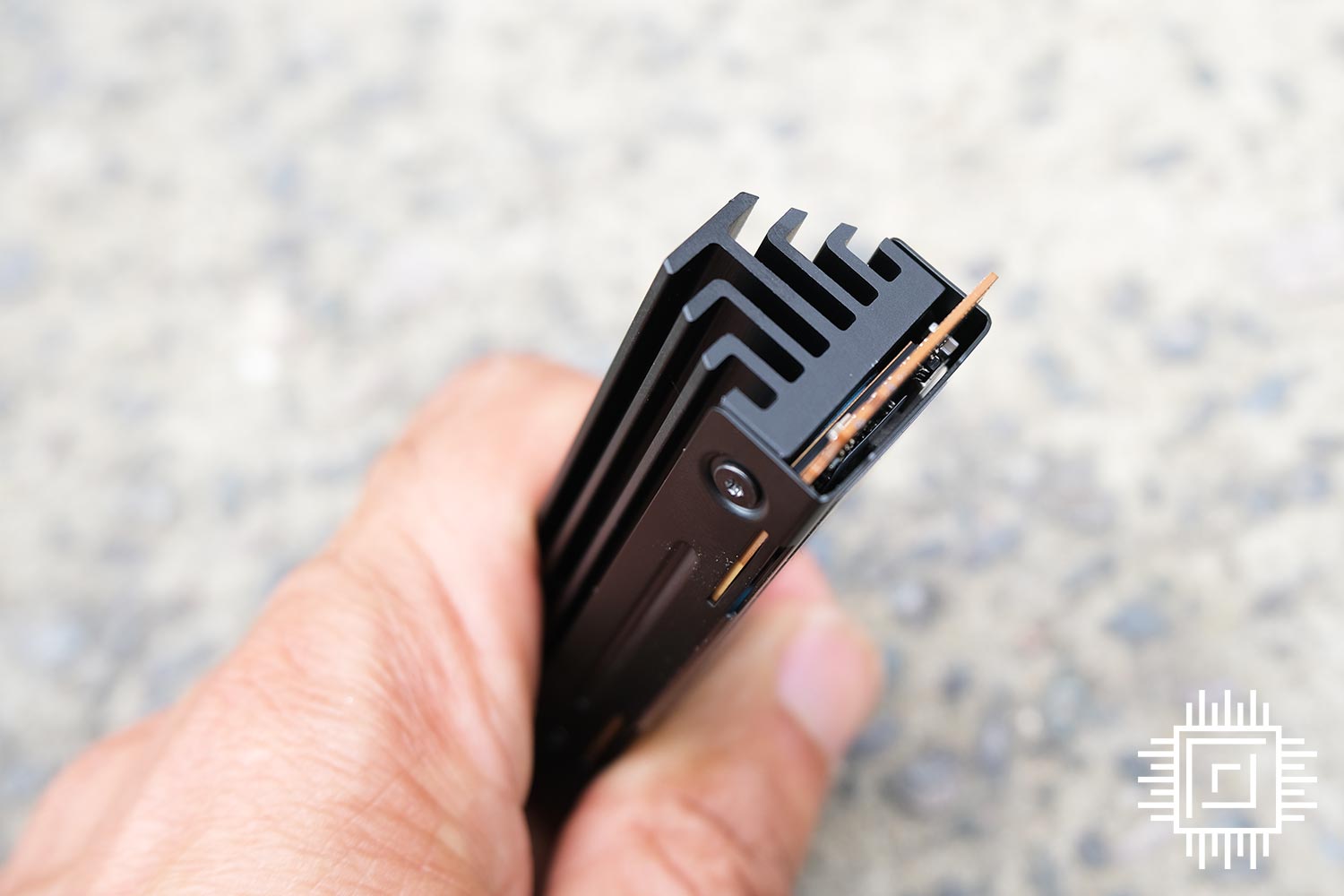
T700 sits on an aluminium base into which the upper heatsink screws into. We know it does a good job at wicking away hotness as thermal imaging readings reveal a maximum surface temperature of 69°C. Toasty but well within the limit. On our 2TB sample know that Crucial uses four chips on the upper side – Phison E26 controller, 2GB LPDDR4 DRAM for buffering duties, and two NAND chips that together comprise 1TB capacity. The remaining 1TB is situated on two rear-mounted ICs, and that’s precisely why the drive sits on a sled. Removing the heatsink is easy enough, though be sure to have a Torx screwdriver in the toolbag. Also be aware that doing so voids the five-year warranty.
The 2TB model is somewhat faster than the entry-level 1TB. This makes sense as the former carries 16 1Tb dies – four on each 512GB of NAND – that interface better with the eight-channel controller.
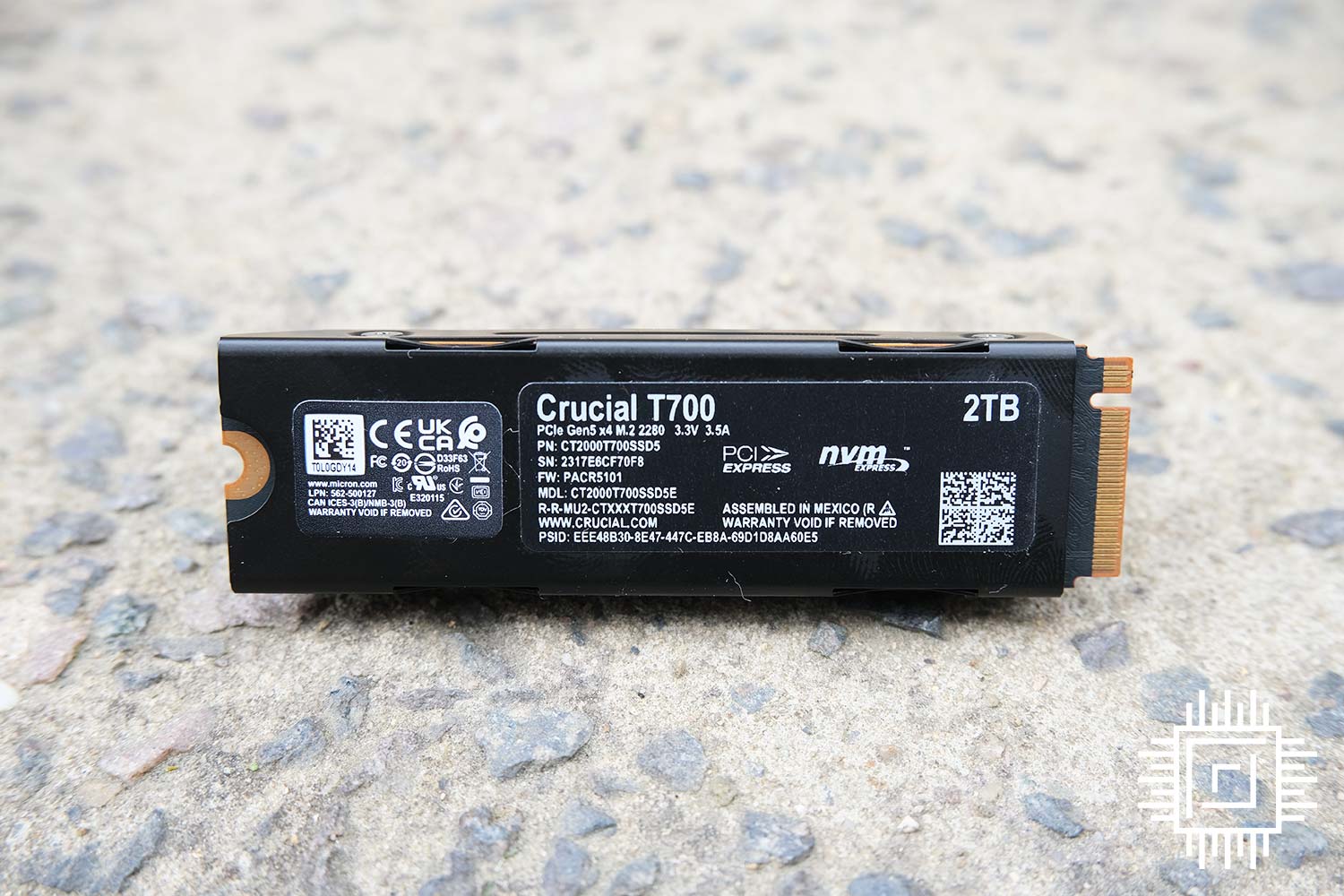
Crucial and Phison interpret specifications differently, actually. The 2TB T700 has an endurance rating of 1,200TBW. That’s perfectly in line with most of the competition using the same hardware, but understand Phison reckons 1,400TBW is possible. Perhaps it’s prudent to be conservative with first-gen PCIe 5.0 x4 drives.
Microsoft DirectStorage-supporting T700 duly takes advantage of Phison’s work by including AES 256 encryption with TCG Opal 2.01 support. Good to see, and 11 per cent of the capacity is dynamically tasked as super-fast SLC memory, meaning uber performance for hot data.
Don’t get your hopes up for the T700 becoming a blistering addition for augmented storage on the PlayStation 5. The heat produced by PCIe 5.0 drives is at odds with the limited space on offer. Do yourself a favour and go for a value PCIe 4.0 SSD instead. In fact, don’t run the T700 bare at all; Crucial is adamant that some form of cooling is needed to keep throttling at bay.
Admit it, the benchmarks are of most interest. Tested on an ASRock X670E Taichi (1.24 BIOS) and featuring the latest SSD firmware, let’s get promptly to it.
Transfer Speed
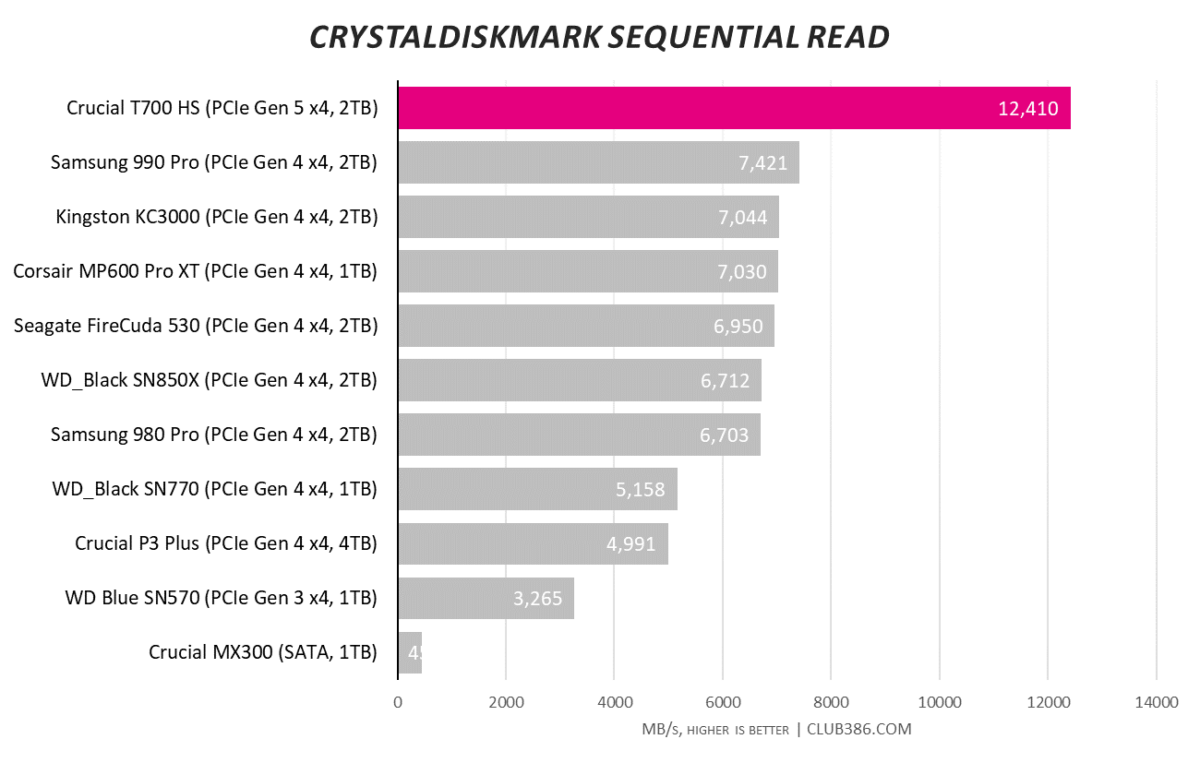
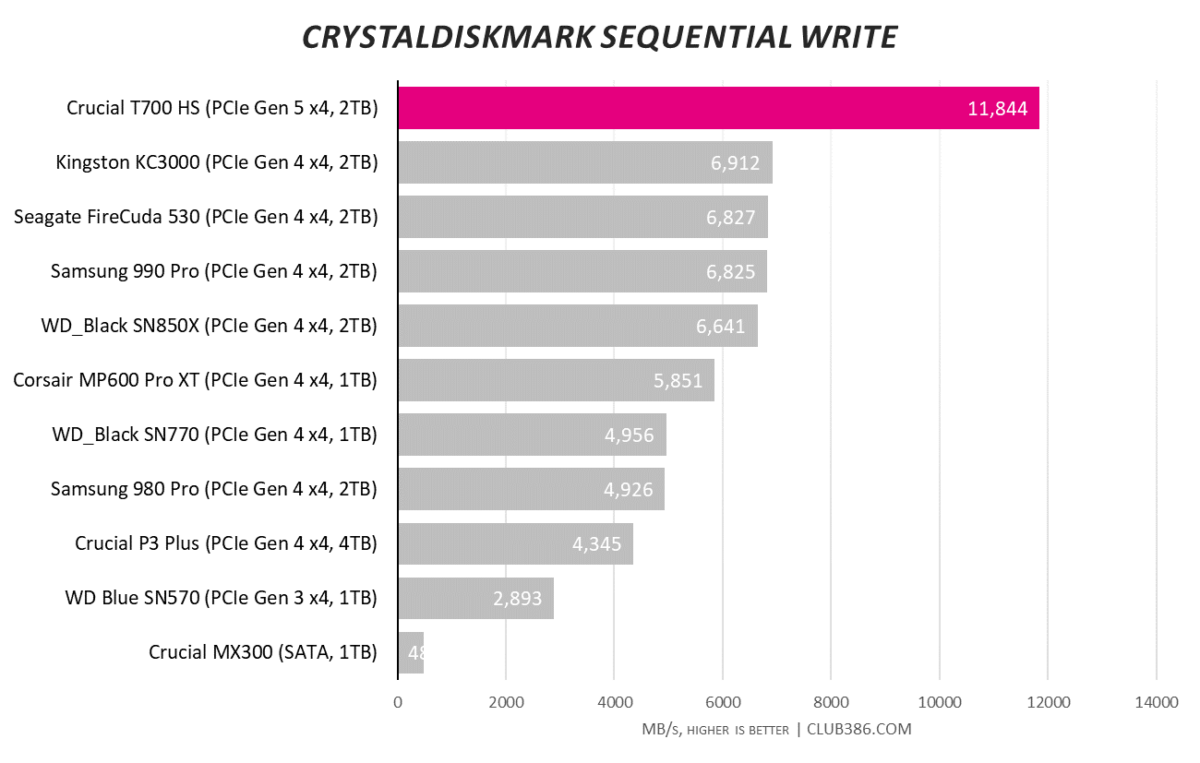
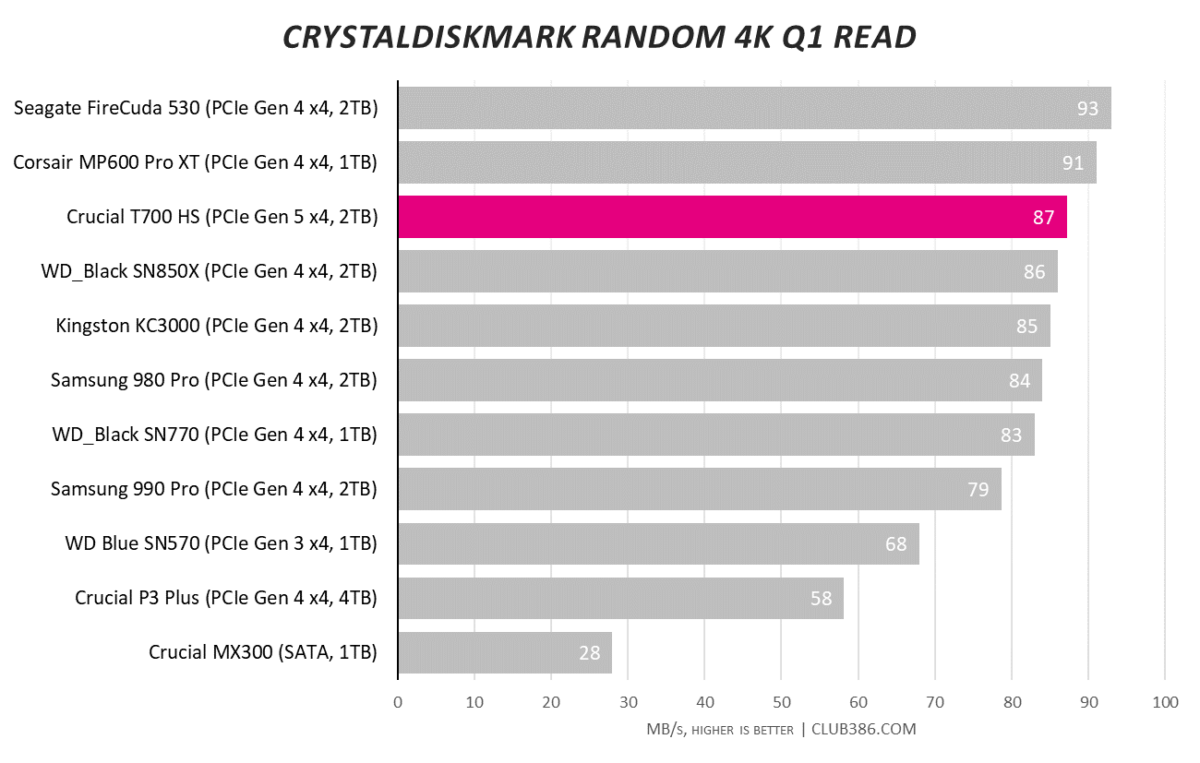
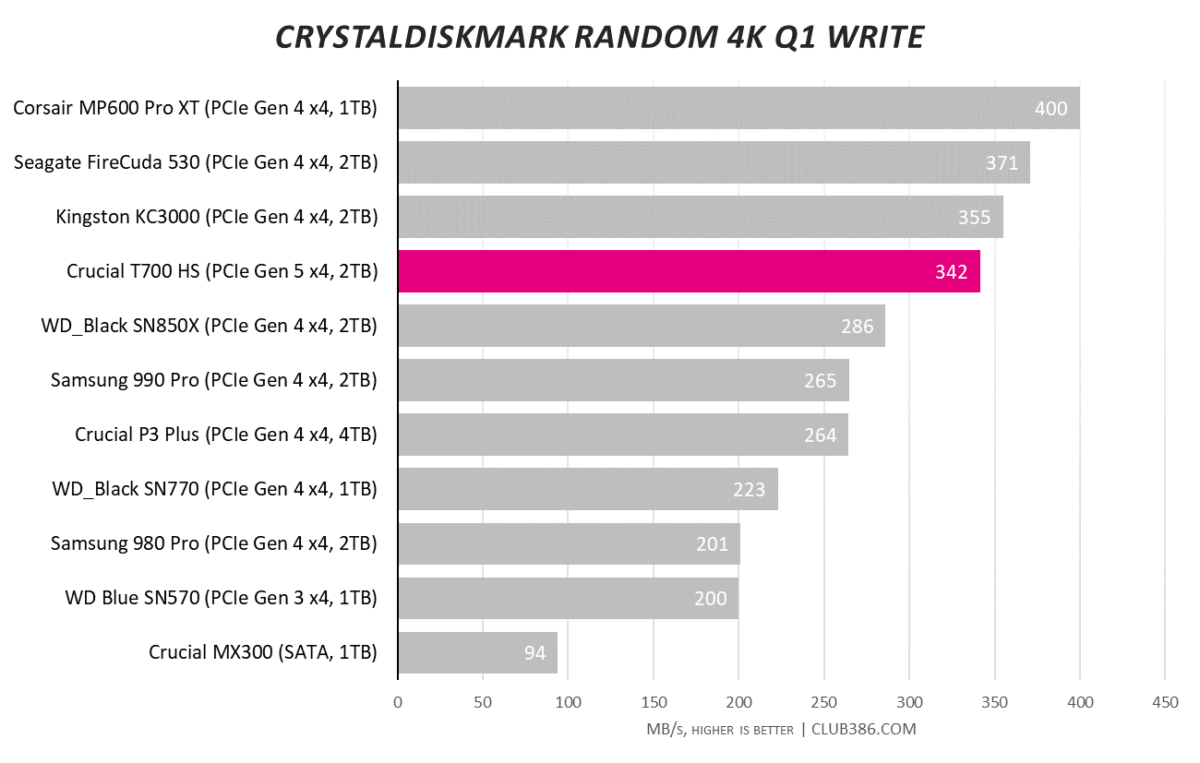
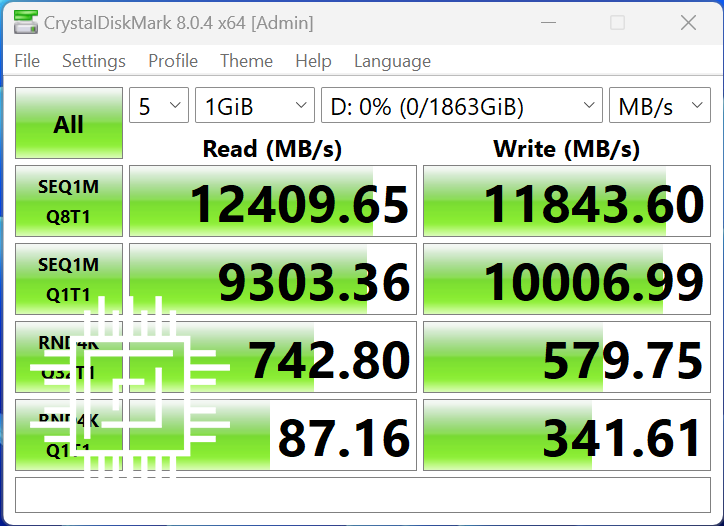
Bish, bash, bosh. 7GB/s is very much yesterday’s news. Crucial duly lives up to specification by hitting the straps in the sequential tests. PCIe 4.0 drives, read it and weep.
Understand that these peak speeds occur when the T700 is in performance-enhancing SLC mode, which is, as noted above, about 11 per cent of the total capacity. Numbers drop down after this small cache is filled; we’ll determine by how much further down.
Gaming
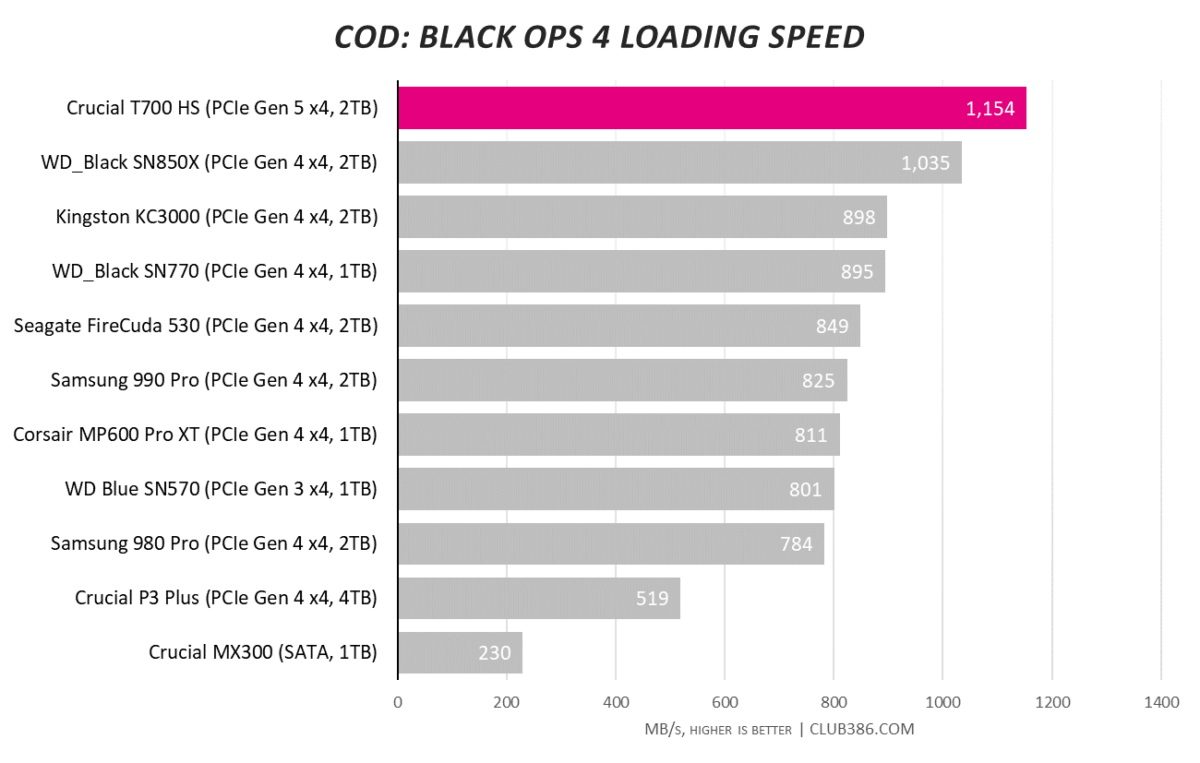
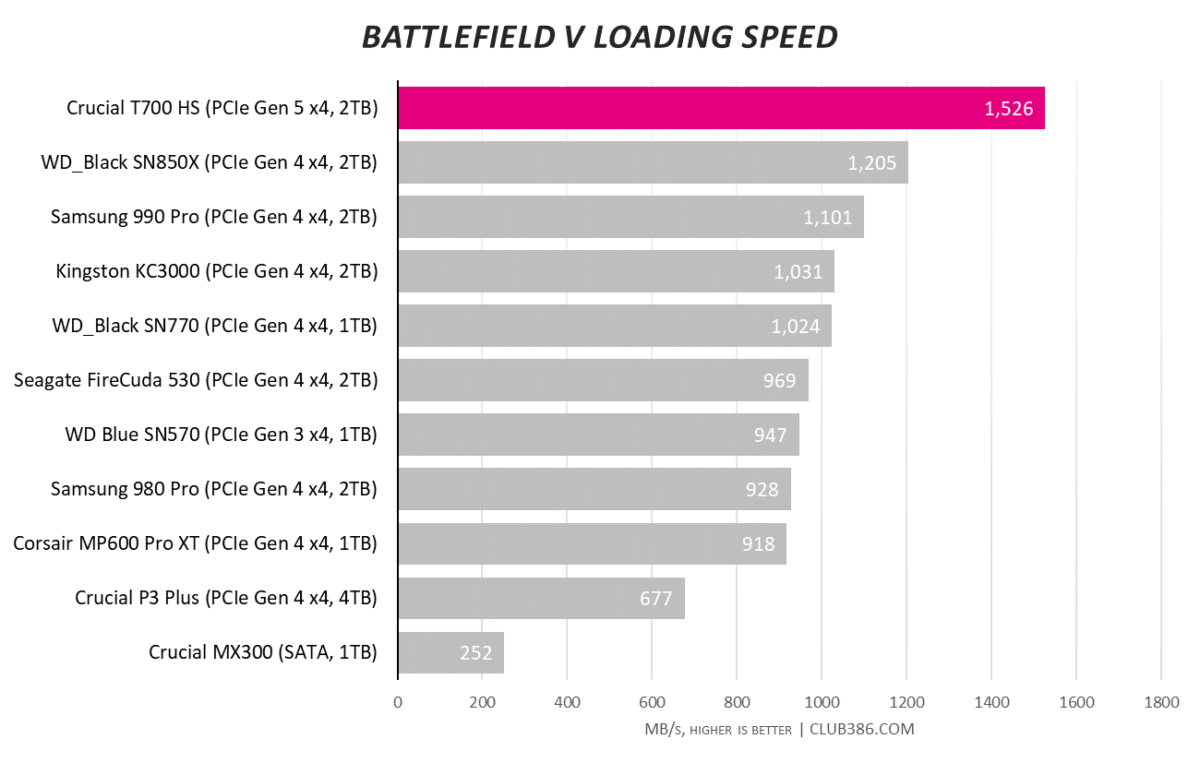
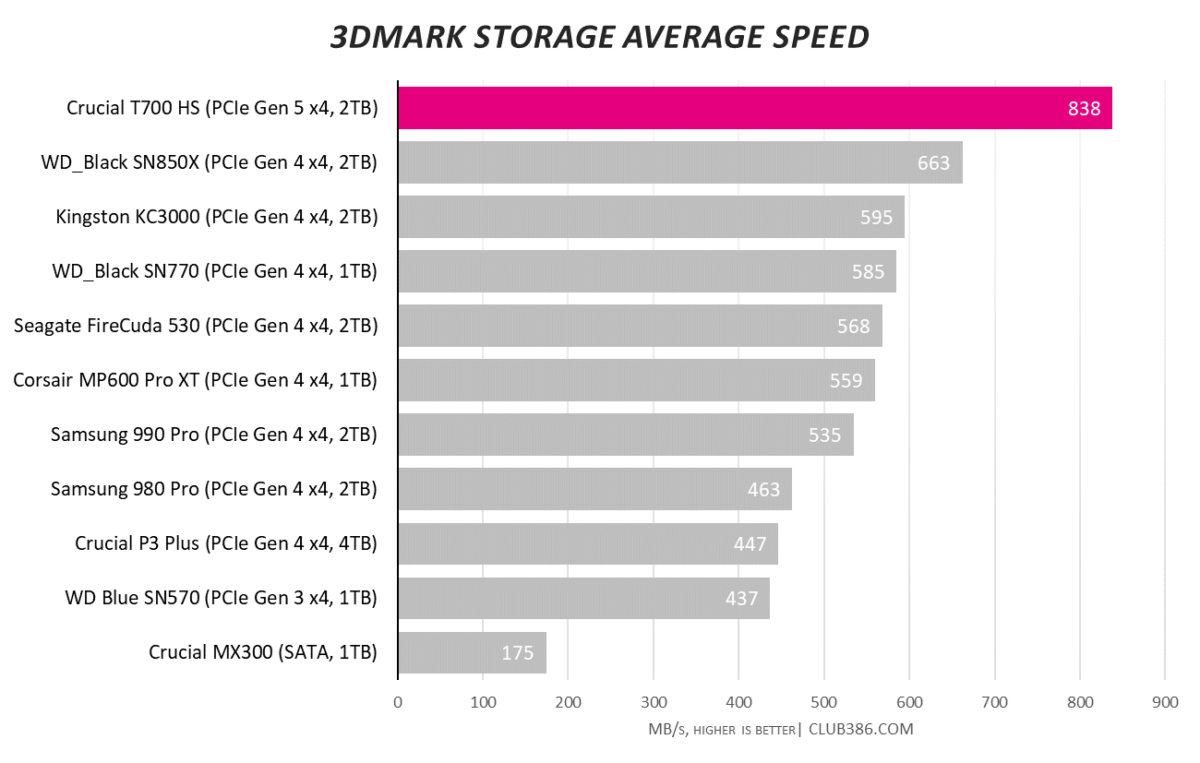
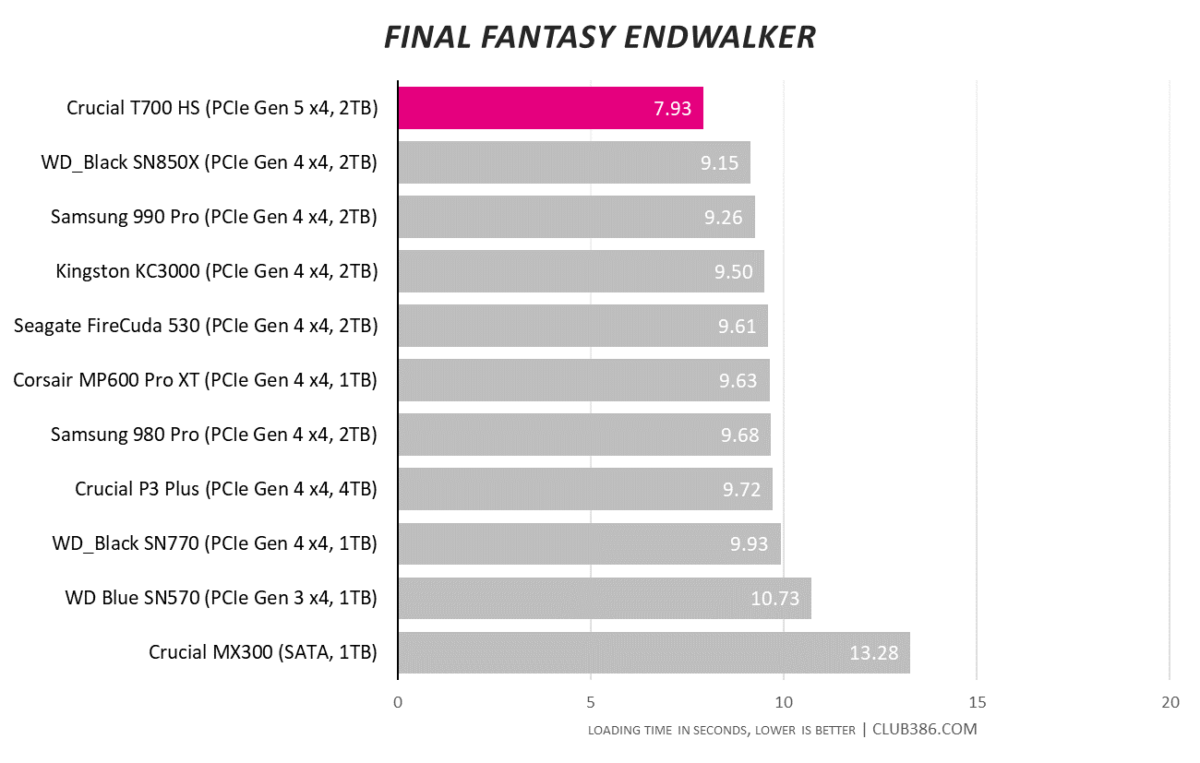
Yes sir, Crucial T700, please head to the top of the charts in an orderly fashion.
Professional Applications
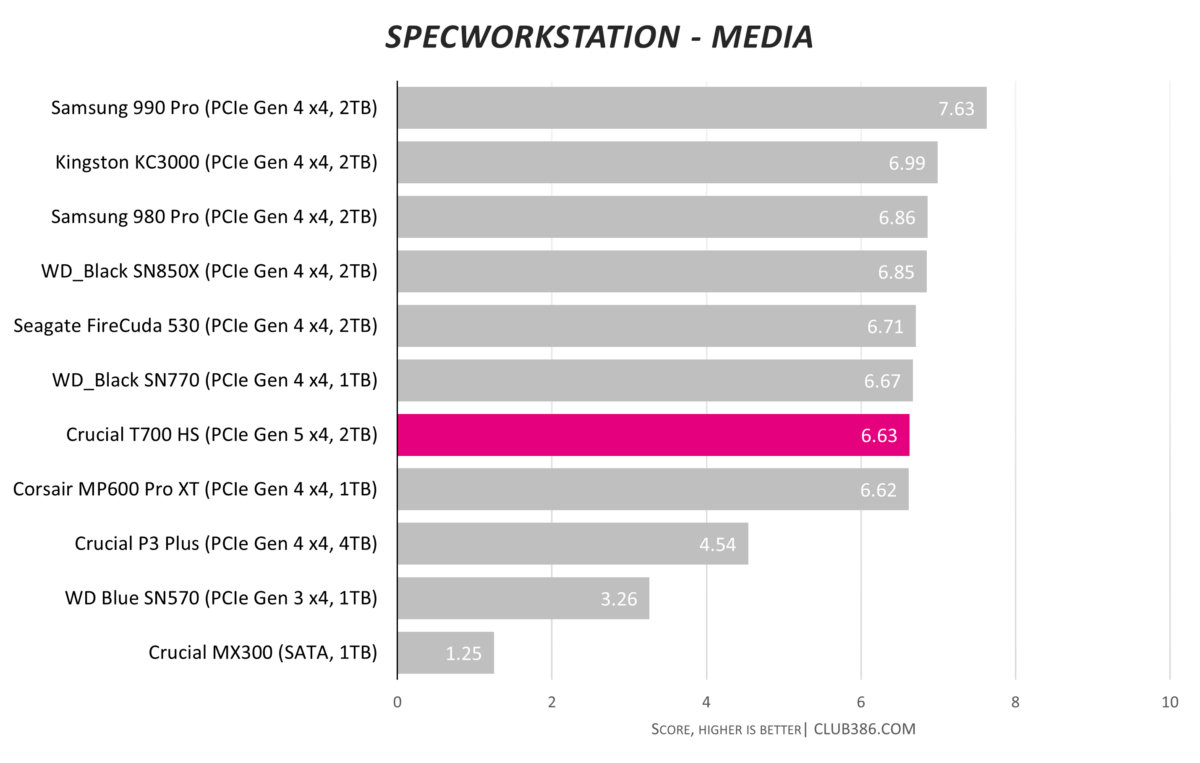
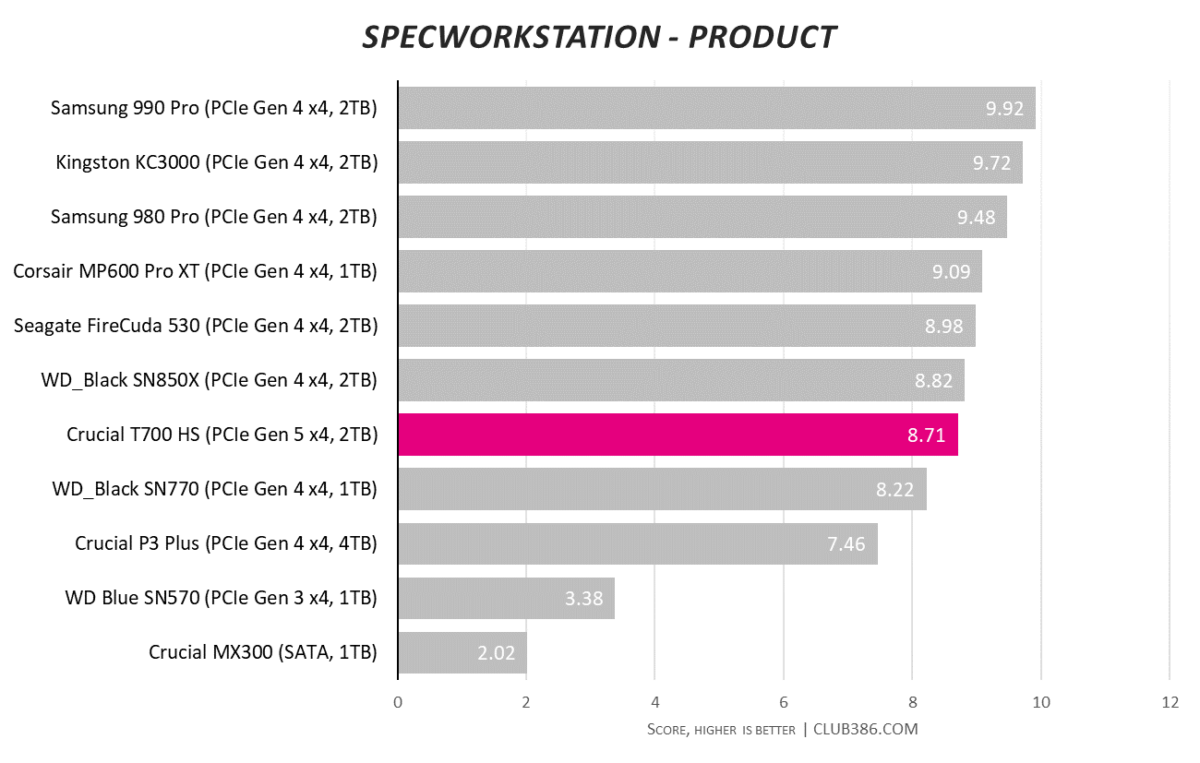
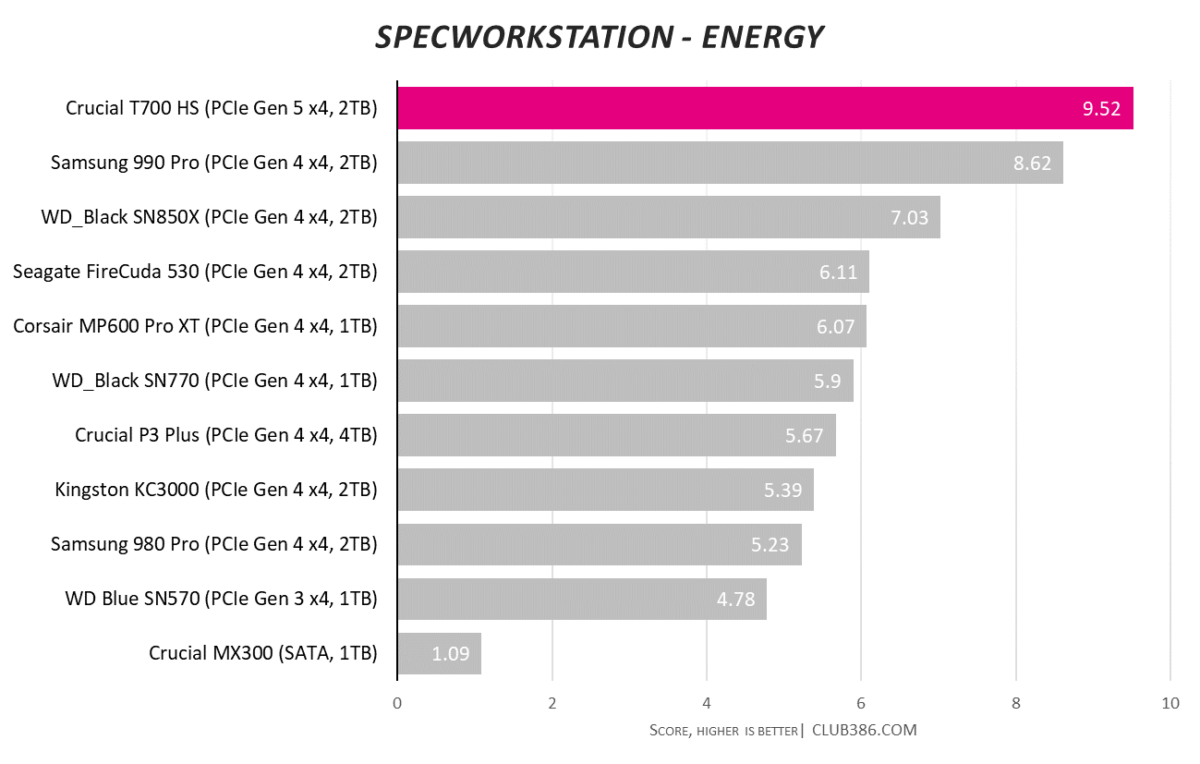
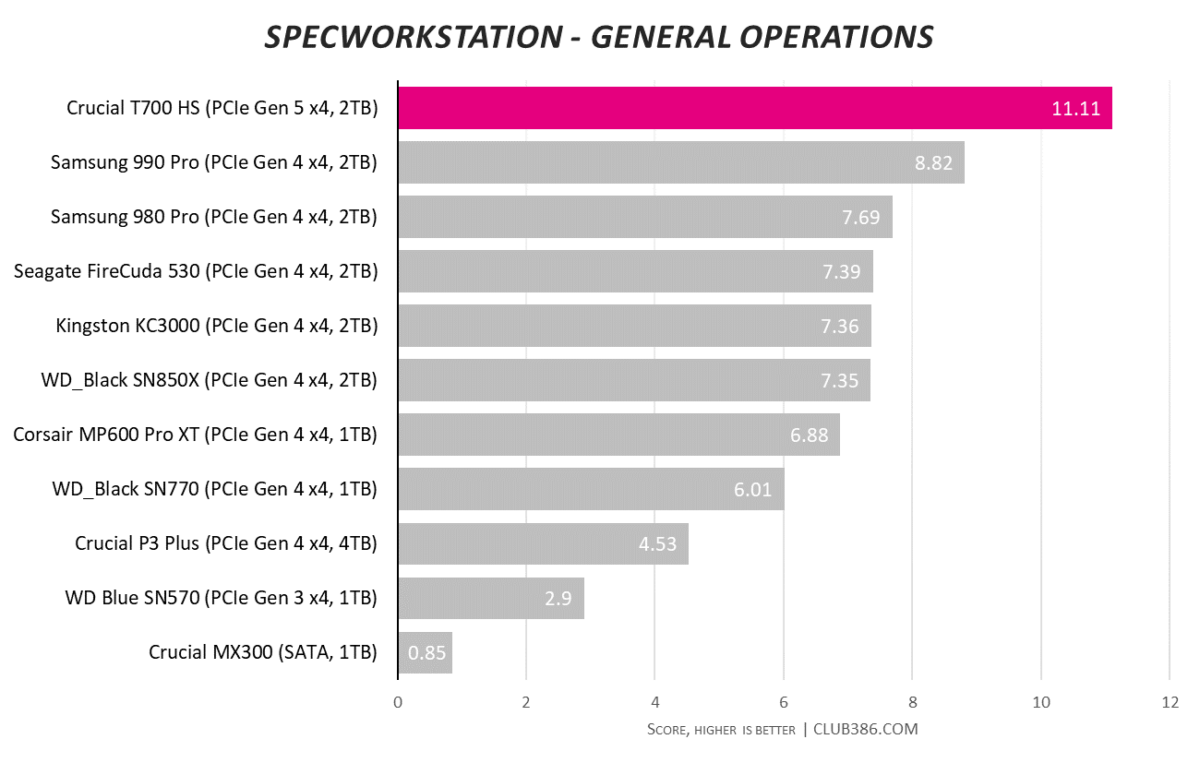
A mixed bag in the first two tests – PCIe 5.0 x4 not playing so well with SPEC, we imagine – normal service is resumed in the final two examinations.
If every last drop of performance matters, you know where to look. Capiche.
Input/output Operations per Second
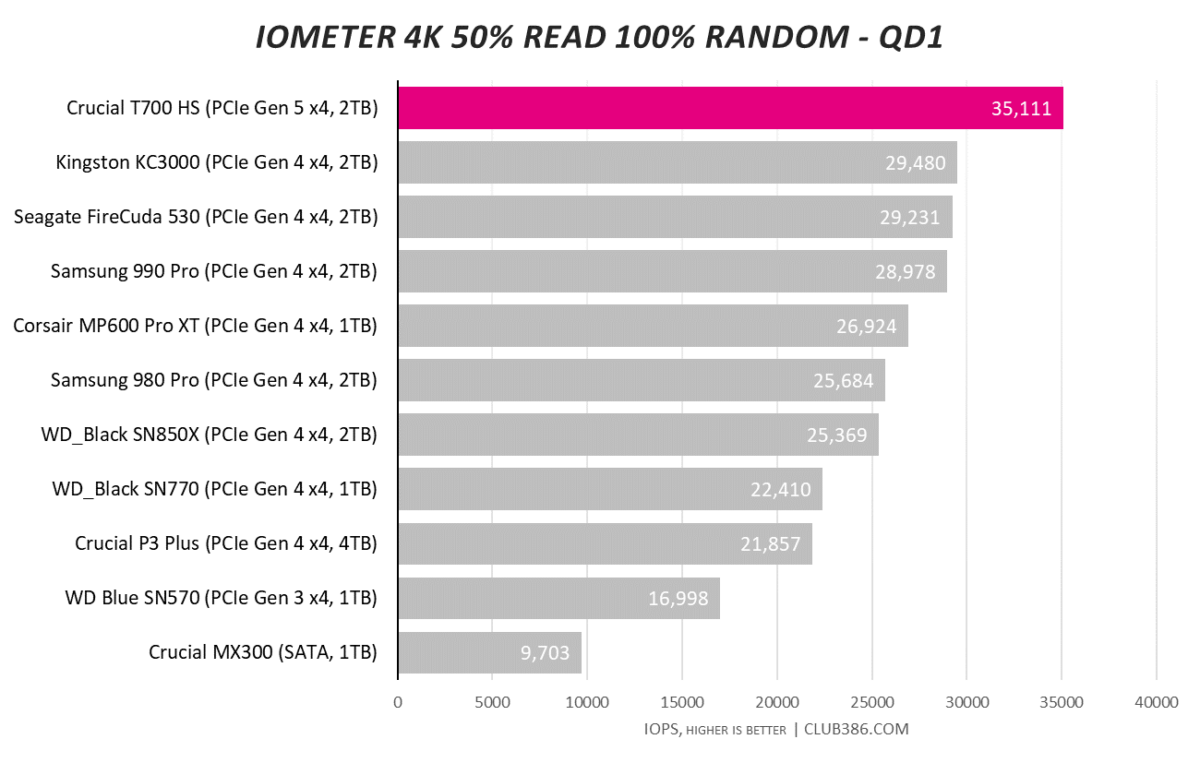
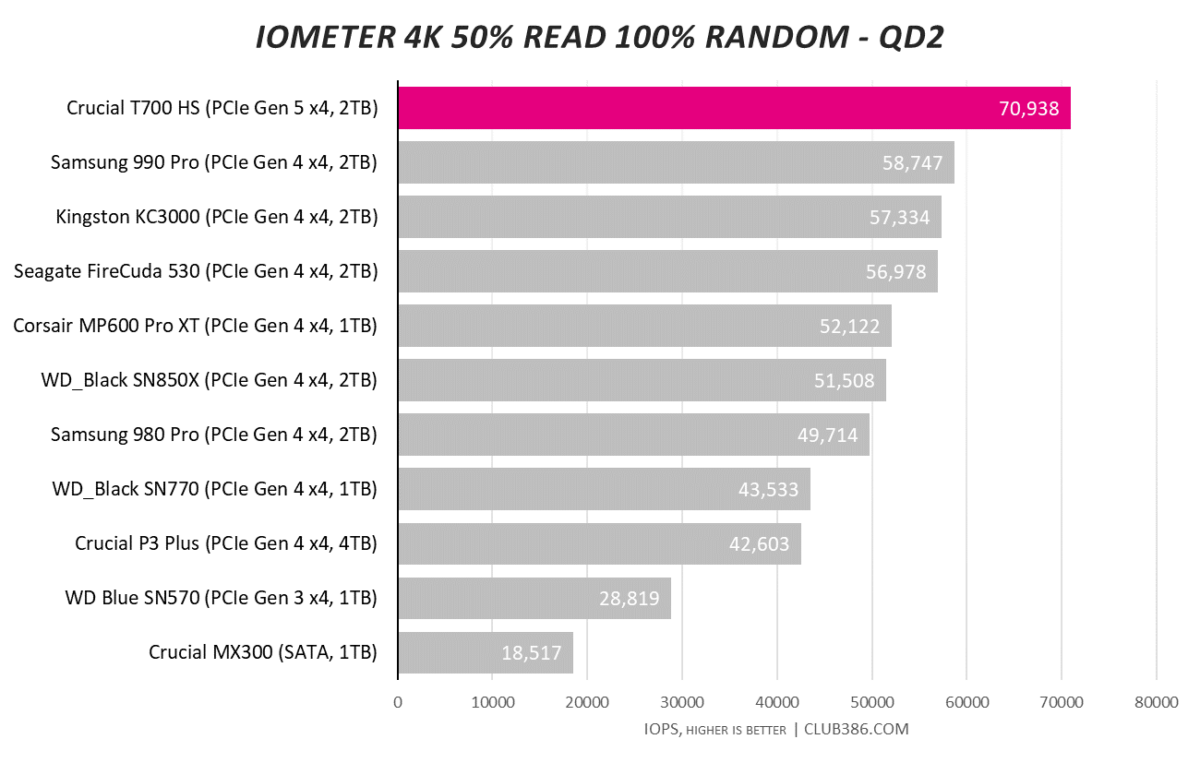
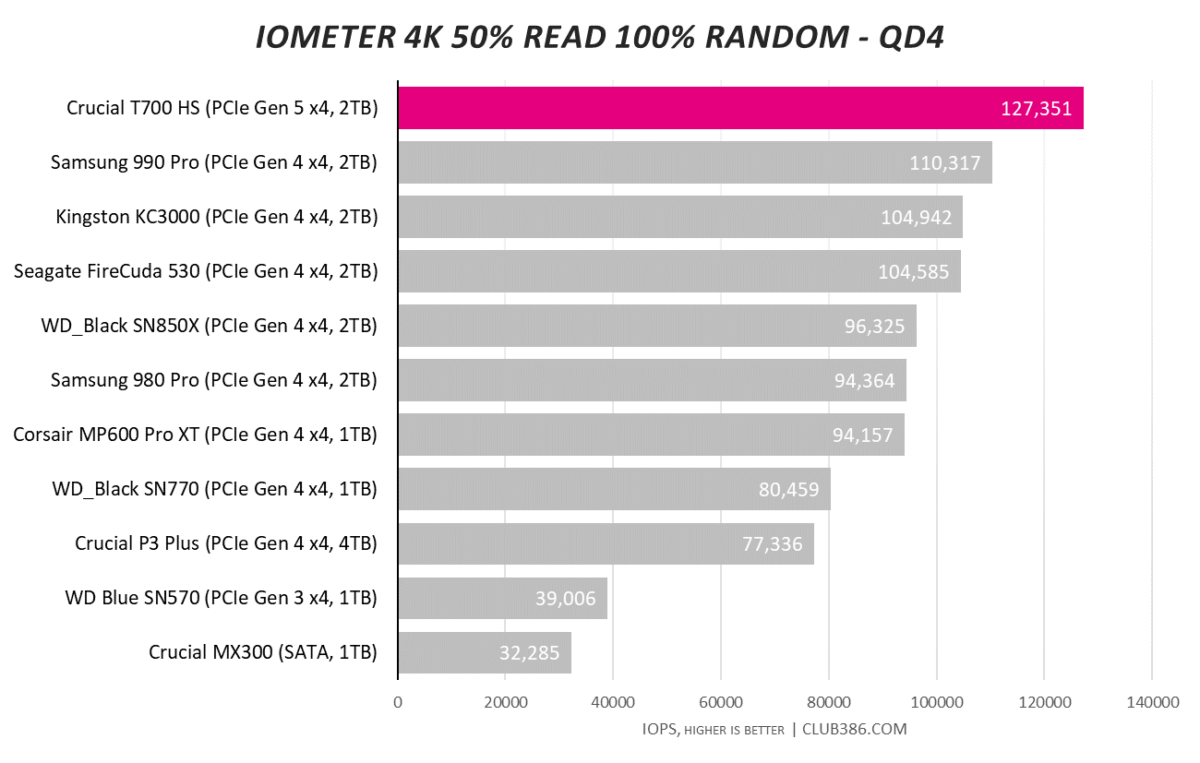
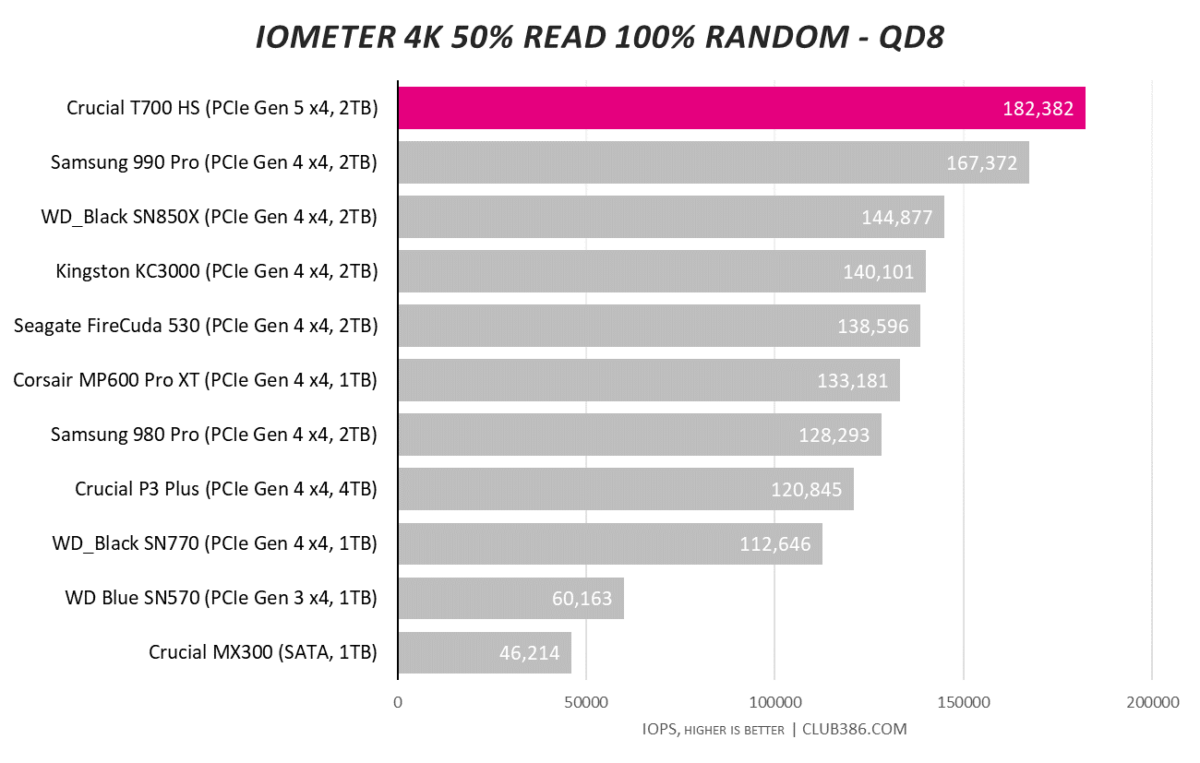
Leading at every checkpoint, the Crucial T700 is particularly strong in the light-load tests. That’s good news for enthusiasts who generally access their drives on a sole-user basis.
Extended Testing
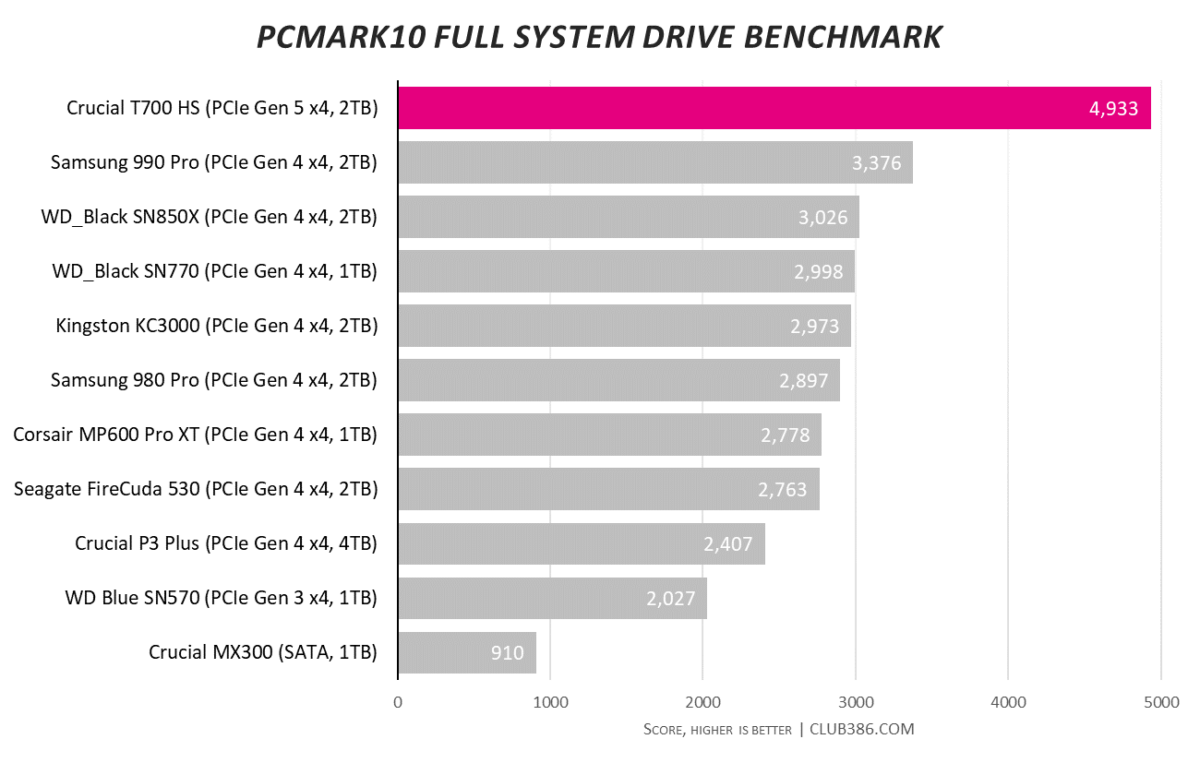
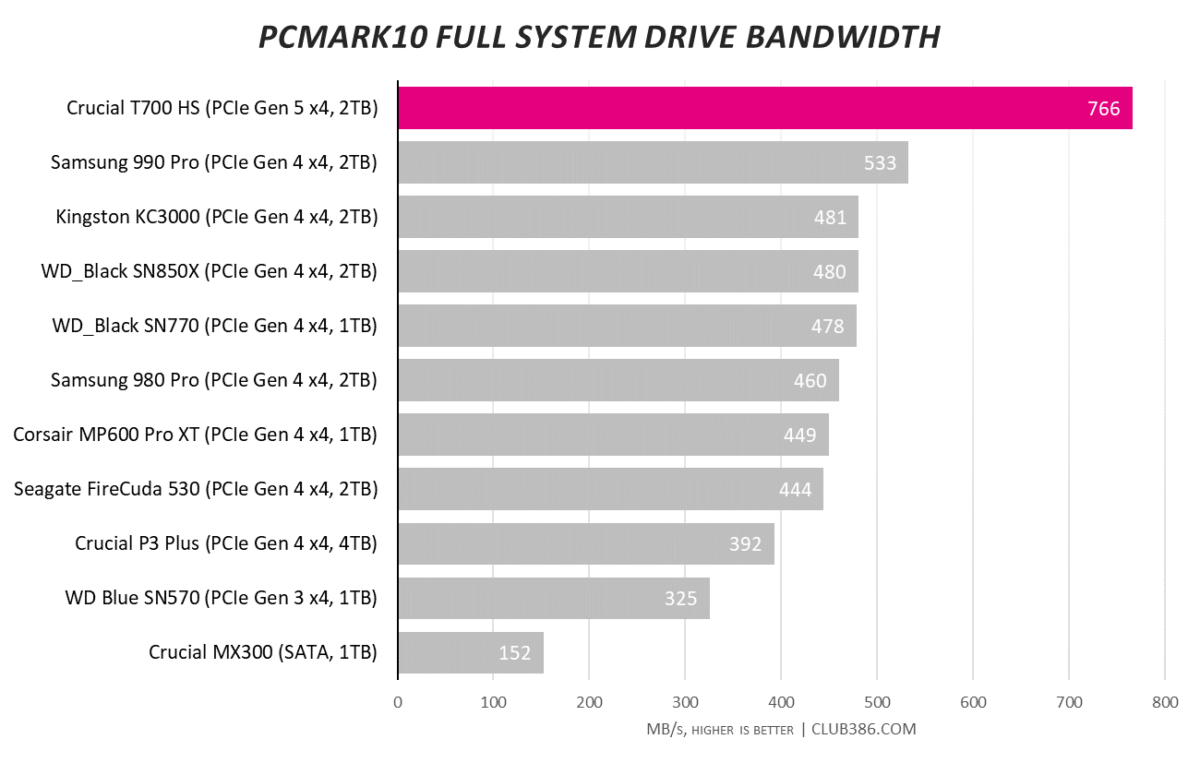
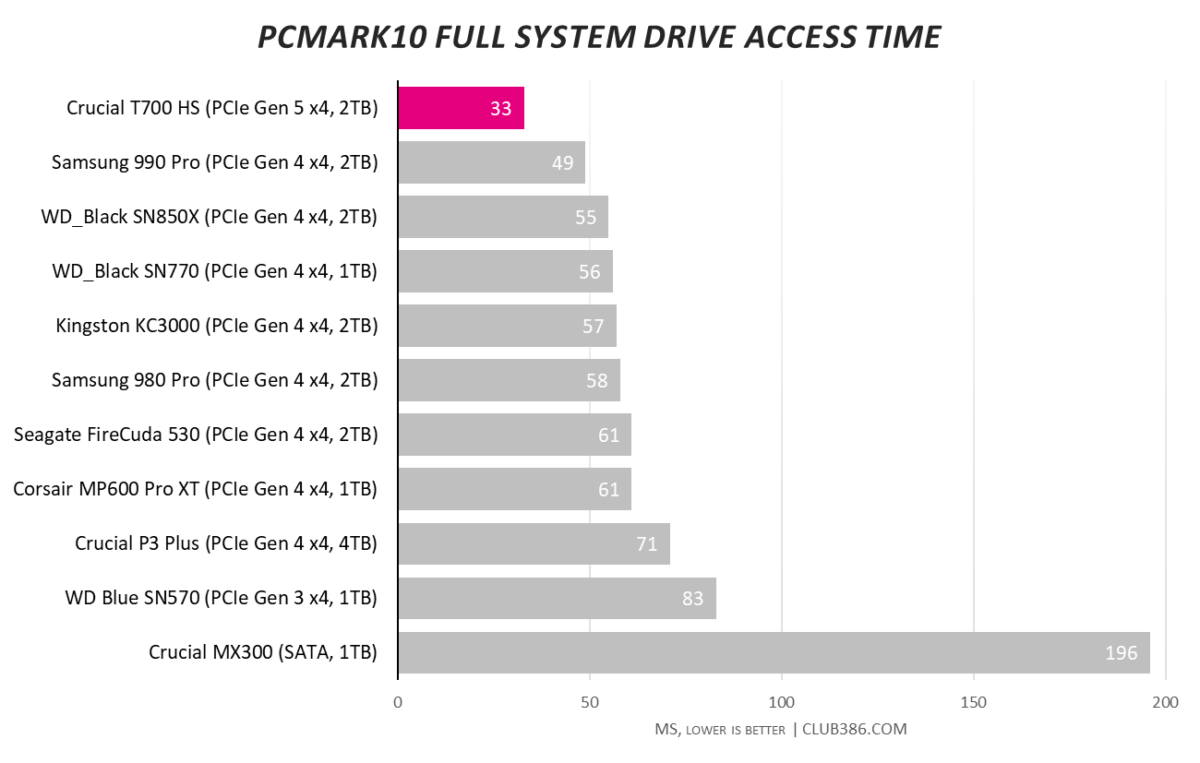
Exemplary performance in the full system drive tests. PCIe 4.0, hold my beer, will ya.
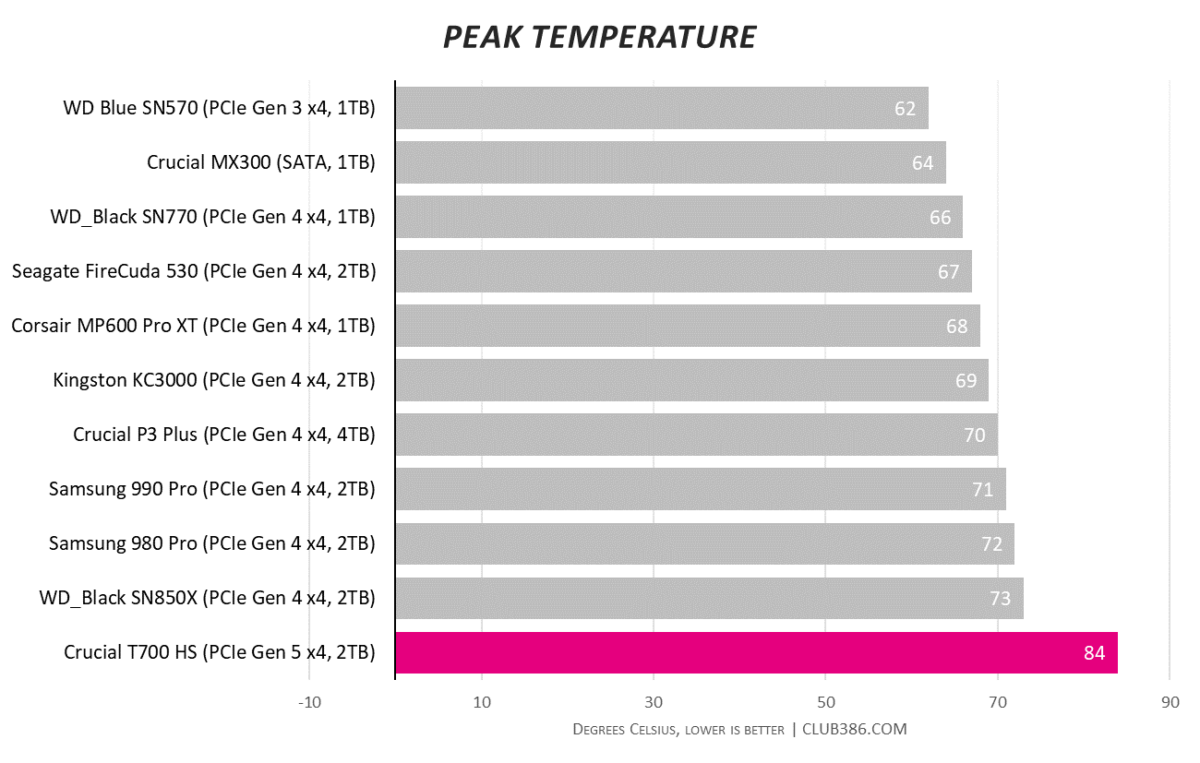
Where there is yin, there is yang, and the price to pay for top-notch numbers is a hot-running drive. The peak temperature is noted after a 20-minute bombardment in the Iometer QD8 test.
Filling the SLC cache in under 30 seconds – which, incidentally, is still long enough for over 250GB/s to be written – T700 then rests at around 4GB/s thereafter, which is plenty fast enough for moving super-large files around.
Conclusion
PCIe 5.0 M.2 SSDs are the next big thing in PC storage. Touting incredible speeds and making a mockery of benchmarks, enthusiasts wanting the absolute best will naturally gravitate toward them. But caveat emptor. PCIe 5.0 drives run hot and the speed difference between them and widely available, cheap PCIe 4.0 is barely noticeable in anything other than benchmarks designed to tease out performance.
Practicalities aside, if you’re the kind of person who won’t settle for second best, Crucial’s T700 has a lot going for it. The heatsink-clad model is beautifully built, stunningly fast, and right at home on the latest Intel and AMD platforms.
Sometimes a product comes along that is a case of want far more than need. The T700 SSD is one of those. If you can justify the stomach-churning price, go right out and get one.
Verdict: Bonkers speed meets an attractive design.


